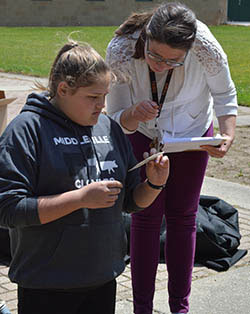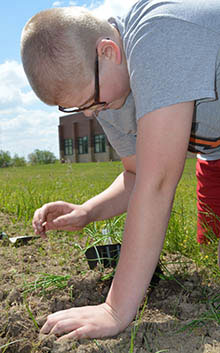Editor’s note: This is a personal commentary by Linda Odette, a School News Network reporter who covers Thornapple Kellogg Schools
“Hey, how did a tomato get into a cherry?”
This question by a middle schooler planting cherry tomatoes at a school garden stopped me. What an incredible, creative way to think about a cherry tomato! I never thought of a cherry tomato that way. When I see a cherry tomato the only thought I have is “eat it.”
Obviously, Thornapple Kellogg Middle School is onto something if students in its first-year garden club are inspired to this type of out-of-the-box thinking. Or they’re having fun while learning to plant tomatoes, cucumbers, zucchini, cantaloupes, squash, onions and about 100 other vegetables in their garden behind the school. OK, maybe not 100.
“I like being out here,” student Gram Price said while working on the plot behind the school, shortly before summer vacation. “I wanted to join to be able to help my parents more in their garden. Ours is three times this big.”

The teacher behind the project is Amy Forman, a resource room teacher. She grew up on a farm in Lakeview, so she knows about gardening.
“Read the tags and figure out how far apart you need to plant them,” Forman told the students at the recent gardening session.That confused a student at the far end of the garden, who yelled, “Mrs. Forman, it says to plant these cantaloupe eight feet apart. If I plant them that far apart there’s not enough room.”
“Aww, don’t worry about that,” replied the seasoned gardener.
Cool, I thought. Not only are students thinking outside-the-box, they’re being taught to question authority, not always follow directions on the package and not to worry, all in a one-hour club after school!
But seriously — and more importantly — the garden is about learning to grow food, science, business and planning skills, nutrition, collaboration and responsibility.

Just Try It, You’ll Like It
The garden club started in February with nutrition and cooking classes from Lisa Thatcher, an instructor with Michigan State University Extension. Amazingly (since beets exist in this world), the middle school students liked everything that was prepared, according to Forman. “The rule was you had to eat one piece and see if you like it,” she said. “Kids tried broccoli for the first time.”
I didn’t have the heart to tell her unwanted broccoli can be hidden in pockets, and beets … well, kids are smart, and I think beets taste terrible, so I’m sure somestudents found a place to put them that wasn’t their mouth. That’s beet bias at its best.
I’m giving a little lesson of my own here: It’s OK to have different opinions. And to all you beet growers of the world, please don’t call in anger or send me a box of canned beets.
After getting a taste in their classes, students called businesses in the community to get donations of plants and tools. They plotted out what plants would go where, removed sod and dug up rocks and debris. A volunteer tilled the plot, and on the last day of May students put in the plants.The advanced science class is creating a pollination garden next to the vegetable garden.
Forman said she started the club to give students a new choice of after-school activity other than sports. Club member Jacob Chapman, who doesn’t have a garden at home, thought the planting would be fun and wanted to learn more about cooking. Levi Van Haitsma initially joined the club because he thought it would help him get a Boy Scout merit badge, but even after he found out it wouldn’t, he liked it so much he kept coming.
“It’s a good bunch of kids,” Forman said. “They love it. They want to be here. We have fun.”
Lots of schools have jumped on the school garden-growing trend. It’s not surprising, since the list of lessons that can be learned is about 100 items long. OK, maybe not 100, but it did seem unexpected knowledge cropped up everywhere. (Pun intended.)

A Growing Concern
For example, Gram learned during the cooking lessons you shouldn’t grab a hot cookie sheet. The club also learned the metric system is questionable. That came when a student, after reading from the back of a seed package that said plants needed to be 66 centimeters apart, asked Forman, “How far is 66 centimeters?”
With humorous exasperation, Forman replied: “Why don’t they give it in inches!” And with that, she had taught the group a bit about the controversial history of the metric system and how it’s not all it’s cooked up to be. Did her bias spill out? Yes, but let’s get serious: Have you ever met someone who said, “I just love, love, love the metric system”?
Seeing students from different grades work together, who likely would never have gotten to know one another otherwise, thrilled club member Kylie McCarty. “I like how we get to interact with people from other grades,” said Kylie, who joined the club to learn about gardening and cooking healthier.
The produce from the club’s first year will be harvested this summer and fall for use in school lunches. Jessica Endres, the food service director, will figure out ways to insert the produce into cafeteria offerings. She hopes club members will turn to classmates sitting next to them and say, “You know that cucumber you just ate? I grew it.”
“When students are invested, they get other kids excited,” Endres said. “We’ll be happy if it continues to grow and grow.” (No pun intended. I know because I asked her).
School families and Forman will tend the garden over the summer, and plants harvested early will be frozen by Forman for use later. If there are hundreds of pounds of extra produce, Forman plans to see if they can be sold at the local farmers’ market. (OK, maybe “hundreds” is overly optimistic.)
It was obvious from watching the group plant vegetables that they were having too much fun. But with enjoying your job being a trend of the future, that delivered another lesson: If you can’t have fun at your job, why do it?
I think those words are worth hearing 100 times — no maybe about it.
CONNECT











